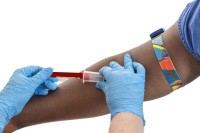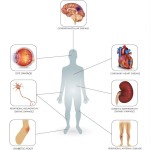- Home
- Dr Sultan Linjawi
Type 1 Diabetes
Type 2 Diabetes
Prediabetes
Gestational Diabetes
- Diabetes Information
- Testimonials
What are the risk factors for prediabetes? Can I change any?

DO YOU WANT TO GET YOUR DIABETES UNDER THE BEST CONTROL?
Click the program that best describes your situation.
What is prediabetes or borderline diabetes?
Prediabetes is a condition that describes a person who has a number of abnormal glucose blood tests suggesting they have borderline diabetes. It may also be called “impaired glucose tolerance” or “metabolic syndrome” or borderline diabetes. People with prediabetes are very likely to progress to developing diabetes in the coming few years. More importantly, people with prediabetes are the most likely to recover and return back to normal by making a few important changes.
Type 2 diabetes mellitus is a very serious condition
People with diabetes who have ongoing high blood glucose levels, are at an increased risk of having poor health outcomes compared to people who do not have diabetes. Some statistics that relate to people with diabetes include:
- People with diabetes are up to four time more likely to suffer heart attacks or strokes
- Diabetes is the leading cause of vision-loss globally and is the fifth most common cause of preventable blindness and fifth more common cause of moderate to severe visual impairment
- Kidney failure is three times more common in people with diabetes
- Amputations are 15 times more common in people with diabetes
- More than 30 percent of people with diabetes experience depression, anxiety, and distress
- Early diagnosis, optimal treatment, and effective ongoing support and management reduce risk of diabetes-related complications dramatically.
PreDiabetes Content |
|---|
| PreDiabetes Program |
| Overview |
| Risk Factors |
| Symptoms |
| Diagnosis |
| Complications |
| Treatment |
| Diet |
| Monitoring |
| Tools |
| Mental Health |
| Prevention |
Who is at risk of prediabetes?
Risk factors can be divided into non-modifiable risk factors and modifiable risk factors. Non-modifiable risk factors are those that can’t be changed by you, for example your genetics. Modifiable risk factors can be changed, for example making changes to the amount you exercise.
You are more likely to get prediabetes if you are carrying weight around your belly. It is much more common in people from certain ethnic backgrounds like Indian, Middle Eastern, south-east Asian and indigenous populations. In these groups rates of diabetes can approach 30% of the adult population. In Caucasian populations, the rates are more typically 10% of the adult population.
Non-modifiable risk factors in prediabetes?
Diabetes is much more common in people from certain ethnic backgrounds like Indian, Middle Eastern, south-east Asian and indigenous populations. In these groups rates of diabetes can approach 30% of the adult population. In Caucasian populations, the rates are more typically 10% of the adult population.
The non-modifiable risk factors which increase your chance of developing prediabetes include:
- Have a family history of diabetes
- Being older (over 55 years of age) – the risk increases as we age
- Ethnic background, including Aboriginal and Torres Strait Islanders, Pacific Islanders, Asian and South East Asian, African Americans, Native Hawaiians, and Hispanics/ Latinos
Being aware of the non-modifiable risk factors is extremely important. For people who have a family history of type 2 diabetes, you need to be more alert and start taking action early to prevent or delay prediabetes from developing into type 2 diabetes.
Modifiable risk factors in prediabetes
The modifiable risk factors which increase your chance of developing prediabetes include:
- Being overweight or obese, particularly extra weight around the waist
- Being physically inactive
- Eating a poor diet (one that is high in fat, salt, and sugar)
- High blood pressure
What can I do to prevent type 2 diabetes?
There are changes you can make to improve your health and reduce your risk of developing diabetes. These include:
- Eating well
- Moving your body more
- Being a healthy weight
- Setting realistic goals
- Getting support
- Make changes part of your everyday
Join the 12-week program to learn how to easily incorporate these changes into your everyday routine.
There is also some evidence that suggests quitting smoking can help to reduce your risk of developing diabetes. While there still needs to be more research done in this by scientists, there are plenty of other great reasons to quit smoking. For example, quitting smoking can help to lower your risk of having a stroke or heart attack.
Making these changes can also help to reduce your risk of developing diabetes comorbidities; hypertension and dyslipidemia.

What are the symptoms of prediabetes or borderline diabetes?
You may have learned that you have some of the risk factors for type 2 diabetes. It is important to look out for any symptoms of diabetes and to see a doctor ASAP if you notice anything wrong.
The most common symptom of diabetes is feeling nothing at all. Yes, nothing. That’s part of the problem. A person with undiagnosed prediabetes feels ok but the damage is already occurring. Many people experience tiredness and fatigue, and that is really noticed when you start to get sugars under control.
In type 2 diabetes, the general symptoms include:
- Fatigue and irritability
- Excessive thirst, frequent urination, and dehydration
- Ongoing hunger
- Yeast and bacterial infections
- Dry and itchy skin
- Cuts and wounds that don’t heal quickly
- Pain and numbness in your feet or legs
- Blurred vision
- Changes in weight
Some symptoms of diabetes can vary between men and women. Symptoms of type 2 diabetes mellitus in men are often related to sexual health and function. The symptoms of type 2 diabetes in women also often relate to sexual health and function.
What should I do next?
If you experience any symptoms of prediabetes or you have risk factors for developing prediabetes, it is important to get tested for as soon as possible. Some people are at higher risk and need regular testing. If you are 45 years or older or have other risk factors for prediabetes and type 2 diabetes, you will require more frequent testing. By diagnosing and treating the prediabetes early, it means you can decrease the risk of developing or delay any further health complications of prediabetes, for example nerve damage, blindness, and heart disease. It is important to know that diagnosing prediabetes should not rely solely on using a Hb A1c test.
Once you learn what your prediabetes status is, or if you already have prediabetes, the next most important step is to become educated. You can join the Personalised 12-week Prediabetes Program to help you learn how to prevent or delay prediabetes. The prediabetes program is personalised and tailored, giving you more of the content that you want. The program also helps you to stay motivated and teaches you what changes you need to make. The first week is free and full of helpful and crucial information.
If you would like to be a part of a supportive program, with easy to understand video content covering all aspects of diabetes, join our Personalised Prediabetes 12-week Program today! Don't forget, when you sign up, you receive the first week free!
Interested in more information on prediabetes?
Follow the links below to learn more about prediabetes.









